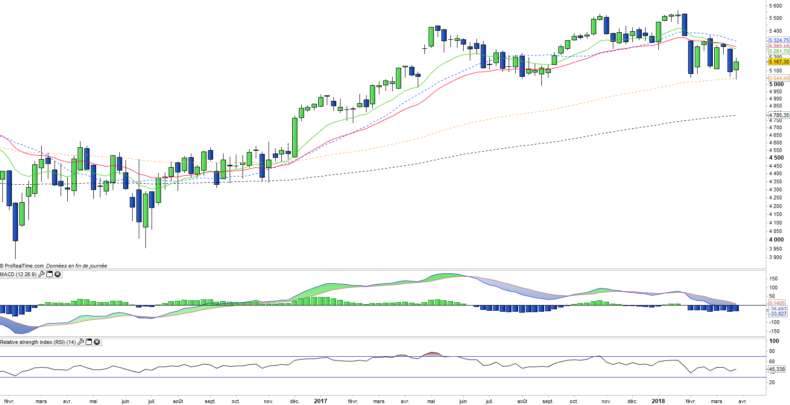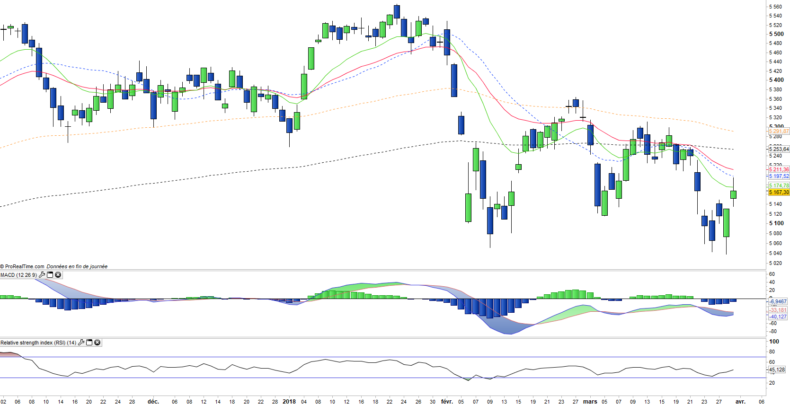Lyxor CAC 40 (CAC) - 03/04/2018
Short Term strategy: Negative (0%) / Trend =
Long Term strategy: Positive (70%) / Trend -
Characteristics of the ETF
The CAC ETF (Lyxor) replicates the CAC 40 index, which is composed of the 40 largest French securities representative of the main sectors of the french economy, while the securities are selected and weighted according to the size of their floating market capitalization.
The costs of the ETF CAC are quite low at 0.25% and the AUM is 4377M €. Replication is direct (physical) and there is a dividend distribution policy.
Alternative ETFS: C4D (Amundi in Euro), E40 (BNP in Euro)
Latest developments
In 2017, the CAC40 achieved a performance of 9.3% and after a favorable start in January is now down -2.7 in 2018 after the correction initiated on Wall Street because of fears of commercial war and the fall in technological stocks in the wake of Facebook.
However, the fundamentals of the French index remain good with expected earnings growth of + 10% this year and a multiple of earnings (PER) of the order of 15x which seems reasonable. The Euro / USD parity remains for the moment stuck between 1.22 and 1.25 and the long-term interest rates remain very low which reinforces the upside potential of the index.
The main risk in the short term is the volatility coming from the United States, for multiple reasons that stem from both a possible change in monetary policy (acceleration of the rate hike by the Fed), unpredictable actions of the Trump administration at the level of world trade, and the rise in long-term rates due to a gradual return of inflation. The risks on the US growth cycle seem more distant because the next recession should not occur before the end of 2019.
In the absence of a major problem, volatility should rather be taken advantage of (opportunistic purchases).
Index & components
It should be noted that the 10 main holdings (which represent about 52% of the index) belong to very different sectors, unlike the DAX (overweight in industrial stocks) or the FTSE100 (pharmacy and financials), the CAC40 is indeed more composite in its sectoral composition. However, two high-weighted stocks, Total (9.7%) and Sanofi (6,6%), can influence the index according to their own fundamental factors, which represents a bias.
From a sectoral point of view, we can see that the consumer goods sector represented by luxury goods and cosmetics such as LVMH or Loreal, is the most important for the index (19.7%), followed by industry (18.7%), financials (13.9%) and energy (9.7%).
The CAC40's stocks are often world leaders with a very international exposure, and little dependence on the domestic market and with a strong sensitivity to the US Dollar.
French macroeconomic statistics have improved significantly since several months, but especially investors regained confidence with the election of Mr Macron, a liberal and pro-European. The risk premium linked to the disastrous catastrophe scenario in the euro zone began to decline as soon as the first poll results were released, but the positive impact on French growth linked to the election momentum and hopes for structural reforms as well as the lowering of corporate and capital taxes confirmed for the 2018 budget are still far from being fully integrated.
France is at the beginning of a new cycle and strong, positive trends could start this time. The medium-term potential of the index is high, as the corporate earnings momentum now seems to have really kicked in after several false starts since 2012 - earnings growth is estimated at around 15% in 2017 and 10% in 2018. Financials should be key, as they could benefit from the gradual rise in long-term rates as growth resumes and higher inflation expectations, as is already the case in the US, coupled with a more favorable political context.
Weekly data
The weekly chart shows a number of bearish attacks across large black candlesticks, immediately followed by a bullish reaction, all forming an accumulation pattern above the EMA100 but capped by the other moving averages in the 5300 pts area. All this forms a zone of congestion between the 5050 and the 5300 points whose direction of exit will condition the trend of the next weeks.
Daily data
On the daily chart, we can observe a short-term bearish movement that develops without great velocity, which shows an hesitation and a market that lacks direction. This hesitation will remain as long as the support of the 5000/5050 points is not crossed down, while the resistance to the rise is materialized by the EMA100 currently located at 5291 pts. This phase of hesitation is found in most of the world's places and first on Wall Street where the direction of the next directional movement should be decided.
ETF Objective
CAC is a UCITS ETF listed in Euro, which replicates the CAC40 index (40 french companies)
Characteristics
| Inception date | 13/12/2000 |
| Expense ratio | 0,25% |
| Issuer | Lyxor |
| Benchmark | CAC 40 (PX1) |
| code/ticker | CAC |
| ISIN | FR0007052782 |
| UCITS | Yes |
| Eu-SD status | Out of scope |
| Currency | EUR |
| Exchange | Euronext Paris |
| Assets Under Management | 4 377 M€ |
| Replication method | Direct (Physical) |
| PEA (France) | Yes |
| SRD (France) | Yes |
| Dividend | Distribution |
| Currency risk | No |
| Number of holdings | 40 |
| Risk | 3/5 |
Country Breakdown
| France | 94% |
| Switzerlad | 3% |
| Luxemburg | 2% |
| United Kingdom | 1% |
| Belgium | 1% |
Sector Breakdown
| BConsumer discretionary | 20% |
| Industrials | 19% |
| Financials | 14% |
| Consumer staples | 11% |
| Energy | 10% |
| Health Care | 9% |
| Materials | 8% |
| Others | 10% |
Top Ten Holdings
| Total SA | 10% |
| Sanofi | 7% |
| BNP Paribas | 6% |
| LVMH | 6% |
| Airbus | 5% |
| L'Oréal | 4% |
| Air Liquide | 4% |
| AXA | 4% |
| Vinci | 4% |
| Danone | 4% |


